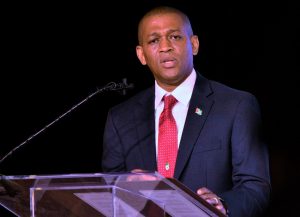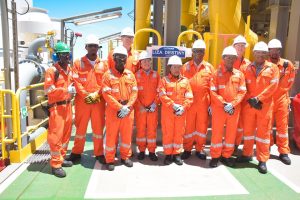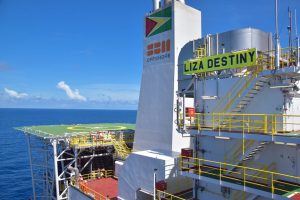DURING the first quarter of 2020, Guyana will begin extracting oil for commercial use. This will be the culmination of millions of dollars spent, several hours of planning, education, and consultation, and an unimaginable number of work hours.
In this edition of Government in Action, the fourth and final part of the series on oil and gas, the Director of the Department of Energy at the Ministry of the Presidency, Dr. Mark Bynoe, addresses some of the misconceptions and common misbeliefs about the oil and gas sector.
Inciting natural disasters

The first misconception involves the safety risks of tapping into Guyana’s offshore oil supply. Many Guyanese believe that removing the oil from below the ground will wreak havoc on the ocean floor, marine life, and even cause earthquakes. Dr. Bynoe addresses this misconception.
“It’s a common perception that persons have, because persons are of the view that… when you hear of a well you get the impression that this oil is just sitting there and you’re drawing it out, but my understanding is what we’re having here is equivalent to like a sponge, and so a sponge, when it’s wet, will ultimately be filled with water. It’s heavy as you draw that water out. That sponge still exists, but it’s a lighter density now. So, that’s the kind of analogy we want to draw between the extraction of oil and earthquakes,” he said.
Dr. Bynoe also briefly explained the true causes of earthquakes.
“Most earthquakes are caused by what we call the shifting of plates. I don’t want to become too technical, but… [the] earth is said to be sitting on a number of plates. When those plates move that is what is said to cause earth tremors. When one plate goes above another it causes what we call folding. So ultimately it is not the extraction of fuel, it is the movement of the plates that will cause earthquakes,” he said.
According to the University of Michigan, the most common earthquakes are caused when pieces of rock break from the built-up pressure of two plates rubbing against each other. That sudden burst of energy produces seismic waves that make the ground shake.
The University also says that it is possible for human intervention, like underground explosions for mines or subways to release seismic waves. However, waves strong enough to mimic large earthquakes are only possible with the detonation of nuclear weapons.
PTO
To add, Petroleum Geologist at the Ministry of the Presidency’s Department of Energy, Ms. Marissa Foster, who was afforded the opportunity to look at Guyana’s Floating, Production, Storage and Offloading (FPSO) the Liza Destiny’s crude oil processing unit, briefly explained the oil pumping process.
“[The] unit… takes the oil after it comes to the surface. It passes through a separator that separates oil from water from gas and then the gas is compressed and it can be injected back into the reservoir. The water is also purified and released into the ocean… The oil after it has been processed, is sent into the tanks below the deck where it awaits the arrival of the tanker for shipping off of the FPSO,” she said.
No jobs for Guyanese

The second misconception concerns the misinformation surrounding local content, which, in this context, refers to the development of a local workforce that is educated and equipped to confidently function within the oil and gas sector.
The companies extracting Guyana’s oil are foreign exploration companies, but that does not mean that they are in control of the sector. Rather than wait for Guyanese to acquire the necessary expertise, the Government of Guyana opted to take advantage of the help given by other countries, international bodies, and companies to build the capacity of Guyanese while the sector emerges.
“What Government has decided to do is to bring in… the expertise where it exists. So, we have been receiving assistance through the Inter-American Development Bank, the World Bank, the IMF, the Government of Mexico, the Government of Canada, the Government of the United States, the Government of the UK… the Commonwealth Secretariat, to assist us to build-out the structures that we need but as we said earlier, to have Guyanese working alongside these experts so that some process of mentorship will occur,” the Energy Director said.
Dr. Bynoe also endorsed the establishment of joint-ventures to boost local business in these early sector stages.

“We are encouraging Guyanese, as far as is practicably possible to establish partnerships, seek for joint ventures… This is not something you will hear about… but when you go out there are a multiplicity of private companies in this country that have already established joint-ventureship. I am not at liberty to name names but I can sit at this desk and say to you, quite a few are already benefiting,” he said.
Guyanese can rest assured that while the oil exploration companies are foreign, the Liza Destiny, belongs to Guyana.
“These are the costs we as Guyanese have to pay. So, I know we have been ceding a lot and saying Exxon’s vessel and ExxonMobil’s first FPSO but as Guyanese we should start recognising these are our monies and so it is a Guyanese vessel pumping Guyanese fuel which will be bringing in Guyanese revenue to help Guyanese ultimately advance and develop,” Dr. Bynoe said.
Oil and gas: a hindrance to sustainable development
To some, the emergence of the oil and gas sector greatly conflicts with Guyana’s Green State Development Strategy (GSDS). This forms the foundation for the next misconception, the belief that Guyana cannot pursue success in the petroleum sector while pursuing a ‘green’ agenda.
For the Government of Guyana, the answer is simple. The revenues afforded through this oil and gas sector will be used for infrastructural development, education, and to boost Guyana’s traditional sectors like, agriculture. Most importantly, the revenues will be used to fund Guyana’s sustainable development.

“Persons have asked, ‘if you have natural gas is that not going against your green ethos?’ My simple answer to that is, not necessarily and let me explain why. Currently, most of Guyana’s fuel is what we call HFOs, heavy fuel oils or diesel. If we are to use gas, it will reduce the emissions from HFOs by 5o per cent. So, while gas is not necessarily ‘green’ it will reduce our own emissions and Guyana is already a net emitter… that means… we have more forested resource than the pollutants that we are putting out. So, we are a net sink. If we reduce that by 50 per cent, we become an even larger net sink,” Dr. Bynoe said.
Dr. Bynoe also stressed that poverty is the greatest threat to a country’s environment. He insists that the Government is right to take advantage of this natural resource to elevate the lives of all Guyanese.

“What provides a greater burden on the environment? Is it poverty or riches? So, are we to have these resources and leave our people in a poverty-stricken state? Development is not just about a ‘green’ environment. In fact, if we look at the [GSDS] it’s not just about leaving things as they are; it’s a development strategy which focuses on social development and also economic development. Here, Guyana has an opportunity to use these resources to pursue what we call sustainable development, so in actual fact [the Government will] use the resources to put in more sustainable entities, because oil and gas will not last. This provides us with an opportunity to do that,” he said.
Guyanese, do not be distracted by the rumours. First oil 2020 is coming and the Government of Guyana, the Department of Energy, and several other State departments throughout the Public Service are readying themselves to exploit the resources in this sector for the benefit of all Guyanese.



.jpg)









